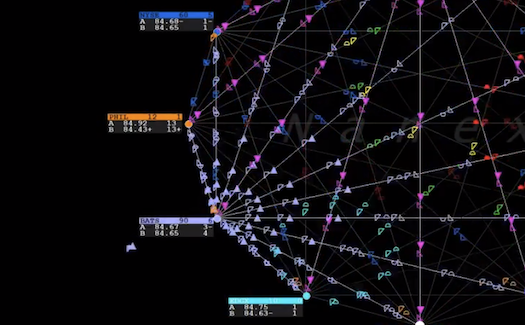What High-Frequency Trading Looks Like Every Millisecond [Infographic]
Check out how much money you’re not making.

Something to think about as the millisecond tick by today: how much money you’re not making from the slight discrepancies between the values of securities on the world’s international exchanges. Developed by suburban Chicago-based financial data company Nanex, this visualization shows, at highly reduced speed, the automated trading activity that took place on Johnson and Johnson’s stock May 2. The timescale bas been altered so that each millisecond of trading time is represented as roughly one second in the visualization, so it’s slowed down about 1,000 times.
The bottom box shows what’s known as the National Best Bid and Offer, or the standard by which all these automated exchanges are supposed to know what the best bid and offer are on a given stock at any given time so a buyer and seller can meet at the best place. All of that other noise? Those are changes in JNJ’s stock price quote being bounced around from various global exchanges (each of the other boxes rimming the circle represents a different stock exchange). The different shapes represent different quote changes, but the point is: look at all those quote changes! Every millisecond!
This is largely the result of high frequency trading, or HFT, in which computer algorithms are constantly trying to find small price discrepancies for the same stock on different exchanges, which are caused by the fact that so much trading is happening so quickly that each exchange can’t always keep up with the rapidly changing price of any security. If an algorithm can spot a millisecond-level opportunity in which a stock is–for the blink of an eye–worth more on one exchange than another, it can make a quick buck (this is called abitrage, and it’s how HFT turns a profit).
So the underlying value of the stock doesn’t matter–HFT generally just exploits pricing opportunity, and in turn the high volume of trading it produces helps to further create delays in the connections between exchanges, which helps create even more opportunities for abitrage. Sounds unfair? Well, it is. Don’t you wish you’d thought of it first?
